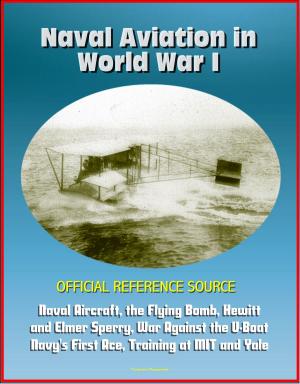The Advanced Surface Force Fleet: A Proposal for an Alternate Surface Force Structure and its Impact in the Asian Pacific Theater - Naval Expeditionary Amphibious Warfare, Power Projection, Sea Strike
Nonfiction, History, Asian, China, Military, Naval| Author: | Progressive Management | ISBN: | 9781370306961 |
| Publisher: | Progressive Management | Publication: | January 10, 2017 |
| Imprint: | Smashwords Edition | Language: | English |
| Author: | Progressive Management |
| ISBN: | 9781370306961 |
| Publisher: | Progressive Management |
| Publication: | January 10, 2017 |
| Imprint: | Smashwords Edition |
| Language: | English |
This excellent report has been professionally converted for accurate flowing-text e-book format reproduction. This study addresses how an alternate surface fleet comprised of aircraft carriers (CVNs), guided missile destroyers (DDGs), and enhanced San Antonio class amphibious transport dock ships (eLPD 17s) of an "equal replacement procurement cost" compare in 14 measures of capabilities to the planned 2040 U.S. fleet, and how the two fleets compare in Asian Pacific Theater operations. The estimated procurement costs for the proposed eLPD 17 class ship and for the Navy's planned 2040 fleet, and the composition of the equal procurement cost alternate fleet, The Advanced Surface Force Fleet, are determined. The two fleets are then compared using three different matrices: 14 measures of capabilities, the capability to conduct humanitarian assistance and disaster relief operations, and the capability to defeat an adversary in a maritime conflict. The Advanced Surface Force Fleet has more offensive capability than the Navy's planned 2040 fleet. Furthermore, the eLPD 17 provides the Navy with an amphibious ship that can act autonomously in contested environments, with more surface ships that have offensive capability, and with a warship that can perform conventional surface combatant roles while maintaining the ability to perform traditional amphibious lift capabilities.
Within any fiscal environment, political and naval leaders have the obligation to ensure taxpayers' dollars are being spent efficiently. As defense leaders prepare for future challenges and threats, they assess the ability of current and future planned naval forces to execute required and potential missions. These assessments lead to programs that support platform acquisition plans, modify them, or add new ones. Force structure is created in this manner, with the naval vessel construction plan being a central pillar. Naval leaders have provided Congress with their naval vessel construction plan; however, as is seen later in this chapter, others have suggested alternative solutions.1 Several have proposed alternative naval force structures, but none have suggested simplifying the surface combatant and amphibious forces to only three ship classes. This study focuses on a new alternative force structure that does just that. Specifically, it addresses how an alternative surface fleet comprised of aircraft carriers (CVNs), guided missile destroyers (DDGs), and enhanced San Antonio class amphibious transport dock ships (eLPD 17s) of an "equal replacement procurement cost" compare in 14 measures of capabilities—to include offensive capability, U.S. Navy (USN) and Marine Corps (USMC) integration, and operating costs—to the planned 2040 United States (U.S.) fleet, and how the proposed fleet may fare in East Asia naval operations.
This excellent report has been professionally converted for accurate flowing-text e-book format reproduction. This study addresses how an alternate surface fleet comprised of aircraft carriers (CVNs), guided missile destroyers (DDGs), and enhanced San Antonio class amphibious transport dock ships (eLPD 17s) of an "equal replacement procurement cost" compare in 14 measures of capabilities to the planned 2040 U.S. fleet, and how the two fleets compare in Asian Pacific Theater operations. The estimated procurement costs for the proposed eLPD 17 class ship and for the Navy's planned 2040 fleet, and the composition of the equal procurement cost alternate fleet, The Advanced Surface Force Fleet, are determined. The two fleets are then compared using three different matrices: 14 measures of capabilities, the capability to conduct humanitarian assistance and disaster relief operations, and the capability to defeat an adversary in a maritime conflict. The Advanced Surface Force Fleet has more offensive capability than the Navy's planned 2040 fleet. Furthermore, the eLPD 17 provides the Navy with an amphibious ship that can act autonomously in contested environments, with more surface ships that have offensive capability, and with a warship that can perform conventional surface combatant roles while maintaining the ability to perform traditional amphibious lift capabilities.
Within any fiscal environment, political and naval leaders have the obligation to ensure taxpayers' dollars are being spent efficiently. As defense leaders prepare for future challenges and threats, they assess the ability of current and future planned naval forces to execute required and potential missions. These assessments lead to programs that support platform acquisition plans, modify them, or add new ones. Force structure is created in this manner, with the naval vessel construction plan being a central pillar. Naval leaders have provided Congress with their naval vessel construction plan; however, as is seen later in this chapter, others have suggested alternative solutions.1 Several have proposed alternative naval force structures, but none have suggested simplifying the surface combatant and amphibious forces to only three ship classes. This study focuses on a new alternative force structure that does just that. Specifically, it addresses how an alternative surface fleet comprised of aircraft carriers (CVNs), guided missile destroyers (DDGs), and enhanced San Antonio class amphibious transport dock ships (eLPD 17s) of an "equal replacement procurement cost" compare in 14 measures of capabilities—to include offensive capability, U.S. Navy (USN) and Marine Corps (USMC) integration, and operating costs—to the planned 2040 United States (U.S.) fleet, and how the proposed fleet may fare in East Asia naval operations.















